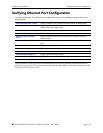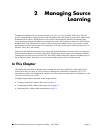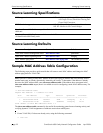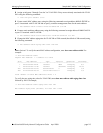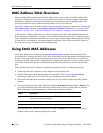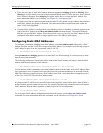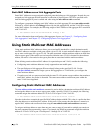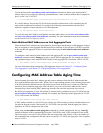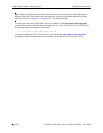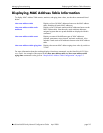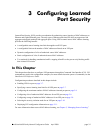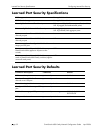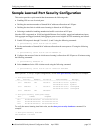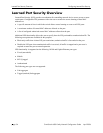
Managing Source Learning Configuring MAC Address Table Aging Time
OmniSwitch 6600 Family Network Configuration Guide April 2006 page 2-7
Use the no form of the mac-address-table static-multicast command to delete static multicast MAC
address entries. For example, the following command deletes a static multicast address that is assigned to
port 2 on slot 3 for VLAN 855:
-> no mac-address-table static-multicast 01:00:02:CE:10:37 3/2 855
If a a MAC address, slot/port and VLAN ID are not specified with this form of the command, then all
static multicast addresses are deleted. For example, the following command deletes all static MAC
addresses, regardless of their slot/port or VLAN assignments:
-> no mac-address-table static-multicast
To verify the static MAC address configuration and other table entries, use the show mac-address-table
and show mac-address-table static-multicast commands. For more information about these commands,
see the OmniSwitch CLI Reference Guide.
Static Multicast MAC Addresses on Link Aggregate Ports
Static multicast MAC addresses are not assigned to physical ports that belong to a link aggregate. Instead,
they are assigned to a link aggregate ID that represents a collection of physical ports. This ID is specified
at the time the link aggregate of ports is created and when using the mac-address-table static-multicast
command.
To configure a static multicast MAC address on a link aggregate ID, use the mac-address-table static-
multicast command with the linkagg keyword to specify the link aggregate ID. For example, the follow-
ing command assigns a static multicast MAC address to link aggregate ID 2 associated with VLAN 455:
-> mac-address-table static-multicast 01:95:2A:00:3E:4C linkagg 2 455
For more information about configuring a link aggregate of ports, see Chapter 12, “Configuring Static
Link Aggregation” and Chapter 13, “Configuring Dynamic Link Aggregation.”
Configuring MAC Address Table Aging Time
Source learning also tracks MAC address age and removes addresses from the MAC address table that
have aged beyond the aging timer value. When a device stops sending packets, source learning keeps track
of how much time has passed since the last packet was received on the device’s switch port. When this
amount of time exceeds the aging time value, the MAC is aged out of the MAC address table. Source
learning always starts tracking MAC address age from the time since the last packet was received.
By default, the aging time is set to 300 seconds (5 minutes) and is configured on a per VLAN basis using
the mac-address-table aging-time command. For example, the following sets the aging time for VLAN
255 to 1200 seconds (20 minutes):
-> mac-address-table aging-time 1200 vlan 255
A MAC address learned on a VLAN 255 port will age out if the time since a packet with that address was
last seen on the port exceeds 1200 seconds. If a VLAN ID is not specified, then the aging time value is
applied to all VLANs configured on the switch.
When using the mac-address-table aging-time command in a switch configuration file (e.g., boot.cfg),
include an instance of this command specifying the VLAN ID for each VLAN configured on the switch.
This is necessary even if all VLANs will have the same aging time value. If there is only one instance of
this command in the configuration file and it does not specify a VLAN ID, the aging time value is applied
only to VLAN 1.



